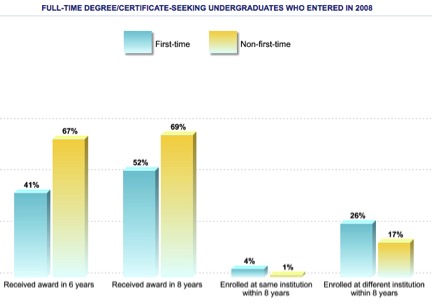Federal Government Publishes More Complete Graduation Rate Data

A guaranteed way to cut the cost of an undergraduate degree is to graduate in four years. But the vast majority of students do not manage to graduate in four years. To be enrolled full-time, students must take 12 credits a semester. To graduate in four years, students must take and pass at least 15 credits a semester.
The official four-year graduation rate for students attending public colleges and universities is 33.3%. The six-year rate is 57.6%. At private colleges and universities, the four-year graduation rate is 52.8%, and 65.4% earn a degree in six years.
The U.S. Department of Education compiles these statistics, but despite being official, the graduation-rate figures aren’t as accurate as you might assume. This is because of the way the U.S. Department of Education requires schools to report degree attainment by students who graduate from their institutions.
Previously, graduation rate statistics were limited to just first-time, full-time students, omitting information about part-time and transfer students. After many years of criticism from pundits in the higher education world about how graduation rates are calculated, the federal government took a major step to make the statistics more relevant by including transfer and part-time students.
The federal government now provides graduation rates for Pell Grant recipients, who represent about a third of all undergraduate students. To understand why this is a move to applaud, you have to understand how graduation rates have always been assembled.
For decades, the federal government has required institutions to provide statistics on the graduation success of students who start as full-time freshmen. These students, who typically begin undergraduate studies right after graduating from high school, represent 47% of undergraduate students.
Graduation statistics for students who began school part-time or who transferred have never been collected. In other words, the data collection system ignored the completion rates of nontraditional students who actually represent the majority of the nation’s students.
Misleading Graduation Rates
Colleges and universities must report how many of their full-time students, who start as freshmen, end up earning a bachelor’s degree in four years. Students, however, who transfer, are counted as never having graduated from their original school.
Here’s an extreme example:
At Chicago State University, a public university, only 52% of full-time students stick around for their sophomore year, which is a stunningly low figure. 48% of freshmen won’t graduate from Chicago State because they left during or after their freshman year.
Chicago State’s four-year grad rate is shocking at just 2.5%. But a much greater percentage of the incoming freshmen will graduate, albeit from another college or university. Moreover, full-time students who transfer to Chicago State also are much more likely to graduate.
Outcome Measures
The federal government is publishing statistics for two-year and four-year colleges and universities that show for the first time how many previously ignored transfer and part-time students are progressing towards graduation for a certificate or degree.
Colleges and universities now report the six and eight-year graduation rates of students who were part-time or who transferred in. You also can see how many students still are enrolled at the institution or have enrolled elsewhere. You can find these figures by pulling up a profile on College Navigator.
Here is an example from California State University–Los Angeles of what you will find:

Looking at national figures, you can see six-year graduation rates:
- Full-time, first-time students: 59.2%
- Transfer, full-time students: 58.9%
- Transfer, part-time students: 37.7%
- First-time, part-time students: 17.7%
The statistics look like transfer students graduate at the same rate as students who stay at their original school. The graduation rates for sophomores who persisted at their original schools are higher than the graduation rates for transfer students.
Pell Grant Statistics
The new statistics also show that Pell Grant students are less likely to graduate than students with higher incomes. According to the new results, 41.2% of Pell Grant students graduated within six years while 55.4% of students who did not qualify for subsidized federal loans or Pell Grants graduated within that time period.
The additional data can make a difference in evaluating schools. Michael Itzkowitz, a former director of the federal College Scorecard and current director at Third Way, used the University of Maryland as an example.
The urban university has a graduation rate of just 10% for its full-time, first-time students. That looks terrible, but it also is misleading since 3% of its students match that description. When part-time and transfer students are included, 43% of students receive a degree within six years.
Researching Graduation Rates
Here are two online resources to check graduation and retention rates:
College Navigator: You can find both the retention rates and graduation rates. You will also see six-year grad rates broken down by race and ethnicity, as well as gender. It’s unfortunate that the government doesn’t provide four-year statistics for these categories.
College Results Online: This contains graduation rates and retention rates for public and private colleges and universities. After finding a school's profile, you can click the Similar Colleges button and generate a list of peer institutions that are ranked by graduation rates and many other measures.
Lynn O’Shaughnessy is a best-selling author, speaker and journalist. Her book, The College Solution: A Guide for Everyone Looking for the Right School at the Right Price, is available on Amazon.com.